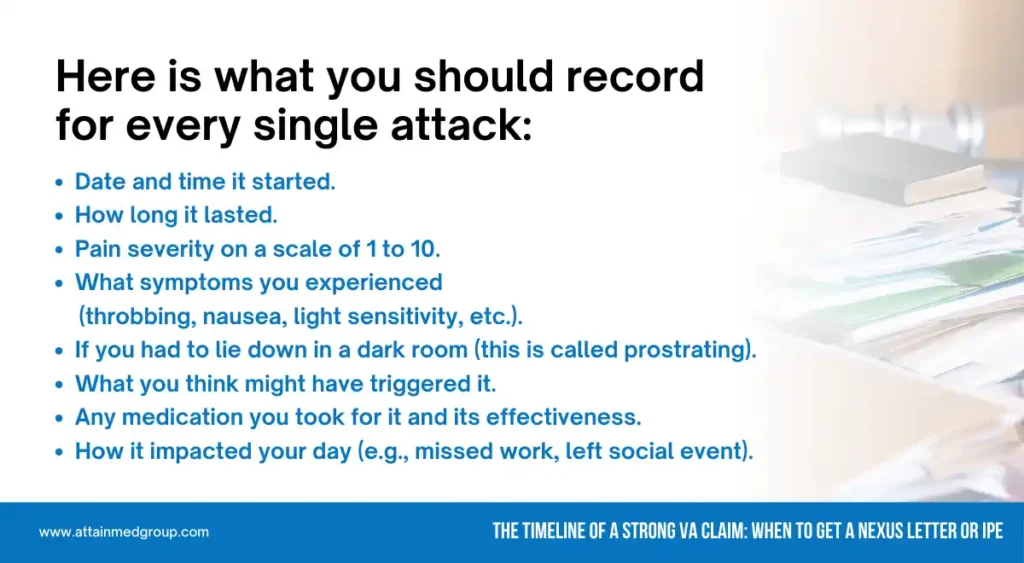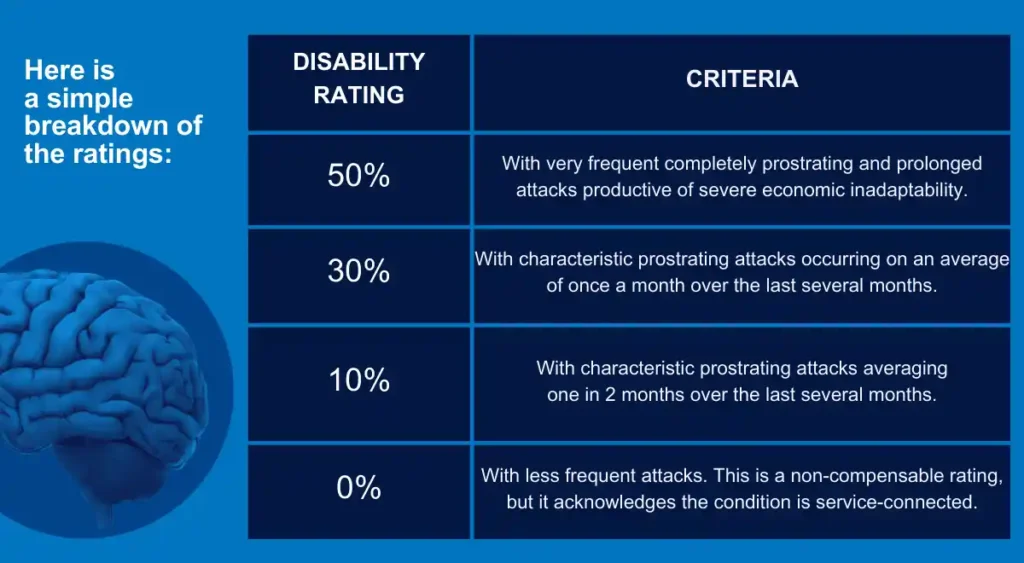That throbbing, pulsing pain in your head feels like a prison. It’s not just a headache; it’s a migraine, and it completely takes over your life. If you’re a veteran, you might suspect this crippling pain is tied to your time in service, but you just aren’t sure how to prove it.
You have come to the right place to learn how veterans can establish a medical link between migraines and service-connected mental or physical injuries. You might be dealing with ringing ears, a bad back, or the weight of a mental health condition from your service. It’s frustrating when you know these issues are connected, but the path to getting the VA to see it too seems foggy.
Making that connection for the VA is completely possible. We are going to walk through how the process for your disability claim works, what medical evidence you need, and how you can build a strong case. You deserve recognition and disability benefits for what you’re going through.

What is Secondary Service Connection?
To start, you need to understand a key idea the VA uses: secondary service connection. It sounds like a complicated term, but the concept is simple. It just means you have a disability that was caused or made worse by another health condition you already have service-connected.
Think of it like a chain reaction. Maybe you injured your knee in the military, and the VA recognizes that as one of your service-connected conditions. But because you walk differently to avoid pain, you develop a serious back problem years later. The back problem can be considered a secondary condition to your knee injury.
Migraines often fall into this category for veterans seeking VA disability benefits. It’s not always a direct injury in service that causes them. They are often the result of other service-connected issues, which is why a VA claim for migraines secondary to another condition is common.
Common Service-Connected Issues That Trigger Migraines
Your migraines didn’t just appear out of thin air. They are often triggered by other health conditions that many veterans face after their service. Recognizing the link between your primary condition and your migraines is the very first step in filing a successful VA disability claim.
PTSD and Mental Health Conditions
Living with Post-Traumatic Stress Disorder (PTSD), anxiety, or depression is a heavy burden. The constant stress and tension take a physical toll on your body. This state of high alert can easily lead to tension headaches that then spiral into full-blown migraines.
Medical studies have shown a strong connection between PTSD and migraines. Veterans with a mental health condition like PTSD are much more likely to suffer from chronic migraines than the general population. The link is so clear because the same parts of the brain that handle stress from events like military sexual trauma are also involved in migraine attacks.
When you have a mental health disorder, your body can be in a constant fight-or-flight mode. This chemical state can directly trigger a headache disorder. Many veterans find their mental health conditions and their headache disorders are closely intertwined.

Tinnitus
Do you deal with that constant, high-pitched ringing in your ears known as tinnitus? It’s one of the most common disabilities veterans claim. Living with that never-ending sound can be incredibly stressful and grating on your nerves.
That constant auditory stress can be a major migraine trigger. Your brain is trying to process this phantom noise all day, every day. This can lead to sleep disorders and exhaustion, which can easily set off a debilitating migraine attack and make a difficult condition even worse.

Musculoskeletal Injuries (Back, Neck, Joints)
Chronic pain is another powerful migraine trigger. If you have a service-connected back, neck, or knee injury, your body is in a constant state of stress. The muscles in your neck and upper back can become incredibly tense from guarding the injured area or from nerve pain.
This tension often leads to what are called cervicogenic headaches, which means headaches that start in the neck. For many people, these types of headaches quickly become severe migraines. It is a direct physical link from the original injury to the pain in your head.
A healthcare provider can help you provide documentation linking the chronic pain from your physical injuries to the development of your migraine headaches. This is a common and logical path for many veterans’ disability claims.

Traumatic Brain Injury (TBI)
The link between a Traumatic Brain Injury (TBI) and migraines is one of the strongest and most recognized by Veterans Affairs. If you suffered any kind of head injury during your service, headaches are one of the most common long-term symptoms. These aren’t just normal headaches, either.
Post-traumatic headaches frequently present as migraines, with intense throbbing, light sensitivity, and nausea. The VA is very familiar with this connection, so if you have a TBI diagnosis from a brain injury, linking your migraines becomes a more direct process. A traumatic brain injury fundamentally changes how your brain functions, making it more susceptible to severe headaches.

Toxic Exposures (Burn Pits, Agent Orange)
Many veterans were exposed to toxic substances during their service. Exposure to burn pits in the Gulf War era or Agent Orange in Vietnam can lead to a wide range of health problems. Some of these health conditions have been granted presumptive service connection.
While migraines themselves may not be on the presumptive list for exposures, the conditions that are can certainly cause them. For instance, Gulf War Syndrome is associated with chronic headaches and other neurological symptoms. Veterans exposed to burn pits may develop respiratory issues or cancers that cause stress and pain, leading to secondary conditions like migraines.
If you have a diagnosed condition related to toxic exposures, you may be able to link your migraines as a secondary health condition. You must show how the symptoms of your primary presumptive condition contribute to or cause your severe headaches.

Your Guide to Learn How Veterans Can Establish a Medical Link Between Migraines and Service-Connected Mental or Physical Injuries
Knowing your migraines are linked is one thing; proving it to the VA is another. You need to gather the right evidence to build a case they can’t ignore. Here are the steps you need to follow for your disability claim.
Step 1: Get a Formal Migraine Diagnosis
First, you need a doctor to officially diagnose you with migraine headaches. Just telling the VA you get bad headaches isn’t enough. You need it documented in your medical records with a proper diagnostic code.
If you haven’t already, go see a doctor or a neurologist about your head pain. Explain your symptoms clearly, detailing the intense throbbing pain and any other issues you experience. An accurate diagnosis from a qualified medical professional is the foundation of your entire claim for VA benefits.
Step 2: Keep a Detailed Migraine Log
This might be the most powerful tool you have. A migraine log is your personal evidence that shows exactly how this condition impacts your life. It moves your claim from “I get headaches” to “My headaches are frequent, severe, and disabling.”
For at least a few months, track everything about your headaches. Be as detailed as you can.

This log shows a clear pattern and demonstrates the severity of your headache disorder. This is crucial for getting the right VA disability rating and showing the severe economic impact on your veteran’s ability to work.
Step 3: Gather Your Supporting Evidence
Now you need to collect all the paperwork that supports your claim. This includes any and all medical evidence that mentions your migraines or the primary condition you believe is causing them. Get records from your service, the VA, and any private doctors you’ve seen.
You should also ask people who see you every day to write a statement. These are sometimes called buddy letters or lay statements. A spouse, friend, or family member can write about how they’ve seen your migraines affect you, force you to miss events, or leave you unable to function.
These personal statements can be very powerful. They provide a real-world picture of how your migraine headaches secondary to another condition impact your daily life.
Step 4: Get a Strong Medical Nexus Letter
This is the piece that ties everything together. A medical nexus letter is an opinion from a qualified doctor that directly connects your migraines to your service-connected condition. It’s a statement from a professional saying, “Yes, it is my medical opinion that Veteran X’s migraines are caused by their PTSD.”
A strong medical nexus will review your medical history and migraine log. It will cite medical research to support the connection between your health conditions. Most importantly, it will use specific language the VA looks for, such as stating your migraines are “at least as likely as not” caused by your service-connected disability.
The VA C&P Exam for Migraines
After you file your claim, the VA will probably schedule you for a Compensation and Pension (C&P) exam. This is an appointment with a VA-appointed doctor who will evaluate your condition. It’s a very important part of the process for all VA claims.
When you go to the exam, be completely honest and open. Do not try to be tough or downplay your symptoms. Describe how you feel on your absolute worst migraine day, not your best, because that is the reality of your condition.
Bring your migraine log and a copy of your nexus letter with you. This gives the examiner solid evidence to review and include in their report. The report they write will have a huge impact on the VA’s final decision on your VA disability rating.
How the VA Rates Migraine Headaches
The VA rates migraines based on how severe and frequent they are. The ratings are meant to reflect how much the condition affects your ability to work and live a normal life. They use a specific term, “prostrating,” which means the headache is so severe you have to stop everything and lie down.
Your migraine log is the best way to prove how often you experience these characteristic prostrating attacks. It shows the rater exactly how you meet the criteria described in the VA’s official rating schedule. This makes their job easier and your claim for VA disability much stronger.

The 50% rating reflects that you experience frequent completely prostrating and prolonged attacks productive of an inability to work. Proving this often requires strong evidence showing that your migraines prevent you from maintaining gainful employment, which may support a claim for total disability based on individual unemployability (TDIU).
Even a 0% rating is valuable. It establishes service connection, making it easier to get a higher rating later if your condition worsens. It also grants you access to VA healthcare and other va benefits for your migraine headaches.
Conclusion
The journey to connect your migraines to your military service can feel long, but it is a fight worth fighting. It begins with understanding the concept of a secondary condition and identifying the root cause of your pain, whether it’s PTSD, tinnitus, or a physical injury. From there, it’s about methodically building your case to get the veterans disability you’ve earned.
By getting a formal diagnosis, keeping a detailed log, gathering your records, and securing a powerful medical nexus letter, you provide the VA with the undeniable proof they need. You’ve earned your benefits through your service and sacrifice. Following these steps will greatly help you learn how veterans can establish a medical link between migraines and service-connected mental or physical injuries and finally get the compensation you deserve.

